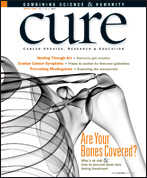Take With Food?
The effect of food on drug potency may justify new research.
It’s no surprise that fods interact with cancer drugs and other medications. Chemicals in grapefruit juice, for example, prevent the breakdown of some drugs in the body, leading to higher-than-expected—and sometimes dangerous—levels in the blood.
Still, it was big news this past summer when two researchers from the University of Chicago calculated that taking a breast cancer drug with food could save patients—and their insurers—$1,700 per month. The “bioavailability” of Tykerb (lapatinib) increases more than three times when the drug is taken with a high-fat meal, wrote Mark Ratain, MD, and Ezra Cohen, MD, in a Journal of Clinical Oncology commentary in August. Their analysis was inspired by a Dartmouth College phase I clinical trial with 27 patients, discussed at the March 2007 meeting of the American Society for Clinical Pharmacology and Therapeutics.
“Thus it is possible that one, 250-mg Tykerb pill, accompanied by food and washed down with a glass of grapefruit juice, may yield plasma concentrations comparable to five 250-mg pills on an empty stomach,” Drs. Ratain and Cohen wrote.
“This certainly isn’t the only drug-food interaction,” Dr. Ratain says, “but this drug is unique in the magnitude of the interaction—even remarkable.”
It’s not just about money, Dr. Ratain says: Taking less of a drug, such as Tykerb, could mean fewer side effects (diarrhea is a major one with Tykerb).
But don’t start cutting your dose. Tykerb’s label—like all drug labels—was written based on phase III clinical trial tests for safety and efficacy, says Sarah Alspach, manager of oncology product communications for GlaxoSmithKline, Tykerb’s manufacturer. In early testing, taking the drug with food produced a wide range of bioavailability—some people ended up with much higher blood levels of the drug than others, probably because of different metabolisms and differences in what they eat, Alspach says.
“The effectiveness of Tykerb depends on the right amount of drug reaching the cancer cells. To make that consistent, it is taken without food,” she says. “There’s no evidence to support that adjusting the dose would be safe or effective.”
Dr. Ratain agrees patients should follow label directions precisely. He’s frustrated, however, by the lack of clinical testing to see if taking less of the drug—with food—could be both safe and effective.
Given the “escalating cost of medications,” Dr. Ratain says, advocacy groups ought to push for tests of Tykerb with food. That’s also true for other cancer drugs, he says. Tests have shown Tarceva (erlotinib), used to treat some lung and pancreatic cancers, becomes significantly more bioavailable when taken with food. However, like Tykerb, the manufacturer directs patients to take it without food to better control its levels in the bloodstream.
Dr. Ratain and his colleagues are practicing what they preach, currently running clinical studies on the interaction of grapefruit with the drug Rapamycin (sirolimus) for patients with lymphoma, multiple myeloma, and chronic lymphocytic leukemia.
Other food-drug research is in earlier stages. In the test tube, chemical extracts from cranberries boost the ovarian cancer-fighting capacity of platinum drugs, which include cisplatin and carboplatin. Nicholi Vorsa, PhD, and Ajay Singh, PhD, natural products chemists at Rutgers University in New Jersey, reported this past summer at the American Chemical Society meeting in Boston that pre-treating ovarian cancer cells with cranberry juice extracts made those cells six times more likely to be killed by carboplatin than untreated cells. Vorsa says it’s not entirely clear how the cranberry extracts may trigger the effect.
Vorsa says it’s no surprise that plants and foods contain powerful chemicals, which may be used in combination with drugs to fight cancer. “Think back to Hippocrates, who said food is medicine and medicine is food. Maybe we’re going back to an old idea here.”
